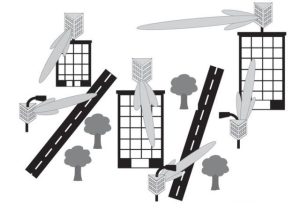Потенційні перспективи застосування повного дуплексу міліметрових хвиль
Повний дуплекс міліметрового діапазону має потенційне застосування в багатьох областях, наприклад, автомобільний радар, 5Г клітинний, мережі міліметрового діапазону, віртуальна/доповнена реальність, і більше.
1 мм хвильової мережі
Все більш щільні пристрої призвели до швидкого зростання трафіку мобільних даних, що спричинило величезний тиск на мережеву ємність. З точки зору системи в цілому, Це вузьке місце і нелегко вирішити.
Низька затримка та низькі витрати на будівництво мережі мають вирішальне значення для з'єднання між 5G невеликими клітинними ділянками та до інших мереж. Розгортання мережі за допомогою волоконної оптики є важким і дорогим, Тож він підходить лише для використання у кожному невеликому 5G клітинному блоці.

Міліметр-хвильові комунікації (наприклад, мережі електронних діапазонів) може вирішити цю проблему, Забезпечення гнучкої та економічної альтернативи для мереж 5G. The 60 Діапазон Гц використовується для бездротового зв'язку короткого діапазону між багатьма пристроями в комірці, і ця смуга може використовуватися без дозволу. The uplink and downlink can work simultaneously, which can reduce network latency.
З цією метою, the E-band uses two different frequency bands (71-76 ГГц і 81-86 ГГц, provided by a waveguide duplexer). Проте, full-duplex can achieve this capability in a single frequency band, equivalent to integrating system capacity in two millimetre-wave bands.
2 mm wave full-duplex relay
A major problem with millimetre-wave wireless communications over low-frequency RF communications is that the signal attenuation is too large, and the signal attenuation in this high-band limits the distance of the wireless connection. In order to extend network coverage and increase link margin, relay nodes can be added between the transmission source and the target to provide a stable connection in harsh environments.

Ця реле з міліметровою хвилею використовує окрему антену для приймача або загальну антену приймача. Для спільних антен, a millimetre-wave circulator can be used to reduce losses while maintaining channel reciprocity.
3 mm wave car radar
In the traditional onboard FM continuous-wave radar, there is an urgent problem to be solved, тобто, the SI signal leakage. SI means that the signal leaking from the transmitting end is directly received by the receiving end, resulting in measurement errors. The antenna interface is not sufficiently isolated, or the reflection of the near target of the bumper or skin of the vehicle will cause SI.
The SI leakage signal input to the receiving end is typically much stronger than the power of the far-end target reflected signal, so the signal must be suppressed to prevent receiver saturation. Технологія придушення SI, розроблена на тлі повного дуплексу міліметрової хвилі, може вирішити проблему витоку сигналу Si радіолокатора транспортного засобу.

У традиційному одно базовому радіолокаторі, Передається та передається спільна антена, і змішувач використовується внутрішньо (теоретична втрата є 3 дБ, зазвичай 4 дБ). Ця втратна пасивна спільна антена може використовувати повністю інтегровану високу ізоляцію кільця з низькими втратами. Замінити його.
4 5G Маленька база стільникової бази
Базова станція Millimetre-Wave 5G Small Cell 5G може спілкуватися з кількома користувачами на сусідніх каналах під час використання висхідної лінії та низхідної лінії зв'язку, що вимагає використання високоякісного міліметро-хвилі дуплексера і є громіздким. Іншим методом є ізоляція передавача та приймача за допомогою повного дуплексного технології

Наприклад, Повністю інтегрована низька втрата, високоізоляція, Циркулятор обробки високої потужності замінює високоякісну міліметрову хвилю дуплексор для досягнення однакової антени як для передачі, так і для отримання.
5 Віртуальна реальність (VR), Розширена реальність (Ar)
Дисплей, встановлений на голові, здатний проектувати високоякісне відео (наприклад, роздільна здатність 2160 × 1200) до кожного ока з високою частотою кадрів (такі як 90 Гц) щоб користувач міг пережити досвід віртуальної реальності. Для запобігання поганого досвіду користувачів (наприклад, запаморочення, нудота, тощо), Відеопотік повинен відповідати високій швидкості (20Гбіт/с) і низька затримка (Менше 5 мс).

Для того, щоб отримати плавний досвід віртуальної реальності, Велика кількість даних повинна передаватися між комп'ютером між комп'ютером, гарнітура та трекер локації, що вимагає двостороннього спілкування. The millimeter-wave full-duplex wireless connection is a promising solution that can completely eliminate the cables on traditional headsets due to its high-speed data transmission and low latency.
Крім того, using the millimeter-wave full-duplex relay function, the signal coverage can be further extended to provide users with more flexible mobility.


